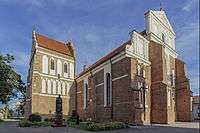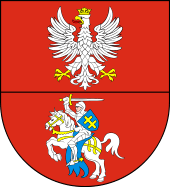Łomża
Łomża (Polish pronunciation: [ˈwɔmʐa]), in English known as Lomza, is a city in north-eastern Poland, approximately 150 kilometers (90 miles) to the north-east of Warsaw and 80 kilometres (50 mi) west of Białystok. It is situated alongside the Narew river as part of the Podlaskie Voivodeship since 1999. Previously, it was the capital of the Łomża Voivodeship from 1975 to 1998. It is the capital of Łomża County and has been the seat of the Roman Catholic Diocese of Łomża since 1925.
Łomża | |
|---|---|
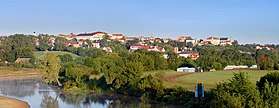 Panorama of Łomża from the south-east | |
 Flag 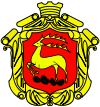 Coat of arms | |
 Łomża  Łomża | |
| Coordinates: 53°10′35″N 22°04′23″E | |
| Country | |
| Voivodeship | |
| County | city county |
| Established | 9th century |
| Town rights | 1416 |
| Government | |
| • Mayor | Mariusz Chrzanowski |
| Area | |
| • Total | 32.67 km2 (12.61 sq mi) |
| Elevation | 95 m (312 ft) |
| Population (December 31, 2014) | |
| • Total | 62 779[1] |
| Time zone | UTC+1 (CET) |
| • Summer (DST) | UTC+2 (CEST) |
| Postal code | 18-400 to 18-404 |
| Area code(s) | +48 86 |
| Car plates | BL |
| Website | www |
Łomża is one of the principal economic, educational, and cultural centres of north-eastern Masovia as well as one of the three main cities of Podlaskie Voivodeship (beside Białystok and Suwałki). It lends its name to the protected area of Łomża Landscape Park. The town is also the location of the Łomża Brewery.
History
Łomża was founded in the 10th century, on the site of the present day village called Stara Łomża (Old Łomża). It was first mentioned in official records in the 14th century. Łomża received its municipal rights in 1416, and became an important political and economic center in the mid-16th century.[2][3] Łomża was a royal city of Poland and the capital of the Łomża Land, an administrative unit (ziemia) of the Masovian Voivodeship of the Kingdom of Poland until it lost its independence in 1795.
Polish Duke Bolesław IV the Curly (Polish: Bolesław Kędzierzawy) built a palace there in the 12th century. In 1444 the town was granted an exemption from the transit tax on Narew river contributing to its further development. In the 16th century King Sigismund II Augustus gave Łomża the right to hold great fairs three times a year, similar to Warsaw and Płock. In 1614 the Jesuits founded a Jesuit College, which as today's I Liceum Ogólnokształcące is among the oldest high schools in Poland. In 1618 a great fire destroyed most of the city, and six years later, an epidemic killed 5,021 persons decimating its population. A series of disasters (including the Swedish invasion and the Cossack raids) resulted in its rapid decline.[2][3]
As a result of the Partitions of Poland Łomża was annexed by Prussia in 1795. In 1807 it was included in the short-lived Polish Duchy of Warsaw. In 1815 Łomża became part of Congress Poland, which was forcibly integrated into the Russian Empire over the course of the 19th century.
_1912.jpg)
In 1892, several members of the Kinlikowsky family made a living of helping impoverished Russians without passports walk through the dense forest to Germany. The Kinlikowsky family would march the Russians to particularly dense areas and then murder them. Other guides found twelve bodies hidden in the overgrowth and reported it to the authorities. The Kinlikowsky family were convicted of murder.[4][5]
During the Polish-Soviet War of 1919-1921, Łomża was directly in the path of the Russian army's catastrophic retreat following its defeat at the Battle of Warsaw. On August 15, 1920, the Soviet General August Kork of the 15th Army mounted an unsuccessful defence of the town against the Polish Fourth Army of General Leonard Skierski, before continuing its retreat eastward under pressure from the Polish forces.[6]
In September 1939, during the joint Soviet and German invasion of Poland, Łomża was largely destroyed by the Wehrmacht during the Battle of Łomża, then held and turned over to the Red Army.[7] Łomża remained under Soviet control until Operation Barbarossa. In June 1941, at the onset of the Russian campaign Łomża was captured by the Wehrmacht and used as a communications hub by the German forces.[8] The Red Army fought back and successfully captured Łomża on September 13, 1944.[9]
Between 1946 and 1975, the oldest part of the city was rebuilt. New housing estates came into existence along with several industrial plants, among them Łomża cotton and furniture factories and starch manufacturing PEPEES, as well as municipal thermal power station. The city transit system was also established during this time. By the beginning of the 1970s, the population had reached almost 30,000 inhabitants.[10]
Jewish community
References to Jewish residents in Łomża date to 1494. The population numbers date back only to 1808, when 157 Jews were officially counted. A magnificent stone synagogue was built there in 1881 on the initiative of Rabbi Eliezer-Simcha Rabinowicz. The Great Synagogue designed by Enrico Marconi became a centre of the Zionist movement.[2] The Lomza Yeshiva attracted hundreds of Orthodox Jewish students, founded in 1883.[11] In 1931, there were 8,912 Jews who lived in the city.
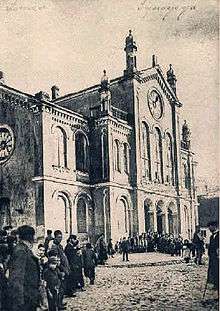
World War I was especially hard on the Jewish community of Łomża, which was a major battle area against German military forces.[12][13][14][15][16] In 1915, the Jewish Aid Society estimated that 22,000 Jewish residents of Łomża were made homeless from the war.[17]
On October 29, 1941, German troops forced over 1,000 Jewish residents of Lomza to kneel in trenches, and they murdered them all with machine guns.[18] They continued murdering entire families.[19]
On 12 August 1941, a Łomża Ghetto was created in the vicinity of the Old Market Square (Stary Rynek). The Nazi Einsatzkommando under SS-Obersturmführer Hermann Schaper committed mass killings of alleged Soviet collaborators a few days later. The number of Jews herded into the Łomża Ghetto from surrounding villages and towns including Jedwabne, Stawiski, Piątnica, Rotki, Wizna, Łomża, and others, ranged from 10,000 to 18,000. Over two-thousand people were murdered in the Giełczyn Forest outside of town. Many Jews perished from malnutrition and diseases such as dysentery and typhus. The rest were shipped to Auschwitz. The Łomża synagogue was destroyed. The ghetto was liquidated in the final deportation action on 1 November 1942.[2][3][20][21] Only a small number of the Jews of Łomża survived the Holocaust; some found refuge with Catholic Polish families.[2] At the end of 1944, the Red Army recaptured the territory. Following the Yalta Conference, the Soviets ceded the city to Poland, with its total population reduced to 12,500 inhabitants, none of whom were Jewish.[22][23]
One of the only visible remnants of the city's Jewish history is the Jewish cemetery.[24] In 1999, the Lomza Jewish Cemetery Foundation was officially founded as a charity devoted to restoring the cemetery, showing respect to the deceased buried there, and to improve relations between Poles and Jews.[24] Łomża declared the Jewish cemetery to be historical sites, and the city erected signed warning that any damage caused would be punishable under the Historical Site Preservation Law.[24] The city also decided to install doors and replace the roof on one of the original cemetery's buildings.[24]
In the 1997, a Torah was discovered that had been hidden in a home in Łomża since World War II.[22] The Torah was discovered while the home was being razed to build new housing.[22] The Torah was bought by Gerald C. Bender, a man living in Illinois in the United States whose father had been born and raised in Łomża.[22] Bender bought the Torah in order to donate it to a synagogue.[22]
Demographics
| Description | Total | Women | % | Men | % |
|---|---|---|---|---|---|
| Population of Łomża | 63,036 | 32,652 | 51.8 | 30,384 | 48.2 |
| Population density (people/km²) | 1,929.5 | 999.4/km² | 930.0/km² | ||
Łomża is the third largest city in Podlaskie Voivodeship with 63,036 inhabitants. At the end of 2006, the population growth was positive and amounted to 1.3% per 1000 inhabitants whereas the balance of migration was negative (-520).[25] The unemployment rate in May 2008 amounted to 10,2%.[26] According to data from 2006,[25] an average income per inhabitant amounted to 2,942.31 zł.[25]
Historical population of Łomża, 1808 – 1931
General population in blue. Number of Poles of Jewish faith in green. Source: Qiryat Tiv'on, Israel.[2]

Religion
The inhabitants of Łomża are predominantly Roman Catholic, although over the centuries in addition to the Catholics, followers of other religions have settled there. There is evidence of many Jewish and Protestant gravestones at the Łomża cemeteries, particularly the two abandoned Jewish cemeteries.
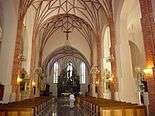 Saint Michael the Archangel Main Nave of the Cathedral
Saint Michael the Archangel Main Nave of the Cathedral Inside the Saint Michael the Archangel Cathedral, tombstone from 1589
Inside the Saint Michael the Archangel Cathedral, tombstone from 1589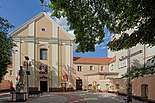 Capuchin parish church (18th century)
Capuchin parish church (18th century)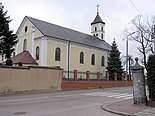 Holy Trinity church (19th century)
Holy Trinity church (19th century)
Education
The history of education in Łomża dates back to the early 15th century, when the first parish was founded. In 1614, Jesuits residing in Łomża created a Collegium (present-day I Liceum Ogólnokształcące im. Tadeusza Kościuszki). One of its rectors was Andrew Bobola. The educational level has not decreased after the KEN school pijarom in 1774. Łomża has educated a number of dignitaries, among others: Szymon Konarski, Rafał Krajewski, Jakub Ignacy Weight, Wojciech Szweykowski, and Adam Chętnik.
Currently in Łomża there is a well-developed network of public and private schools at all levels. There are seven primary schools, eight schools, ten secondary schools, six universities (including three non-public) and two schools of art. The educational level in Łomża is high, based on the results of the exams and countrywide lists. For example, I Liceum Ogólnokształcące rates as a top national and central Poland school.
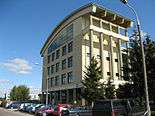 College of Computer Science and Business Administration in Łomża.
College of Computer Science and Business Administration in Łomża. I Liceum Ogólnokształcące, named after Tadeusz Kościuszko (High School No. 1)
I Liceum Ogólnokształcące, named after Tadeusz Kościuszko (High School No. 1) II Liceum Ogólnokształcące, named after Maria Konopnicka (High School No. 2)
II Liceum Ogólnokształcące, named after Maria Konopnicka (High School No. 2)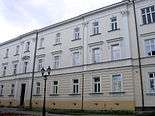 A building of a seminary school in Łomża
A building of a seminary school in Łomża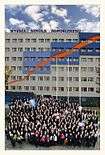 WSA Students group in the front of the main building
WSA Students group in the front of the main building
Economy
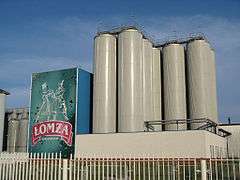
The economy of Łomża is closely connected to its natural environment, with agricultural and forestry industries at the forefront of the region's economic development. The economy is ecologically friendly, including the food industries, brewing, electronics, the manufacture of building materials and furniture, the production and processing of agricultural crops, as well as tourism and agro-tourism. Even the largest companies employ less than 1,000 workers, even though a number of firms are listed on the Podlasie Top One Hundred Entrepreneurs.[27] Among them, the Łomża Brewery (large scale producer of beer), DOMEL (producer of unleaded windows), FARGOTEX (importer of upholstery fabrics), Konrad (importer of farm animals), Łomża furniture factory (Łomżyńska Fabryka Mebli), PEPEES (producer of potato starch), Purzeczko (the personal and property protection). On top of that, the city is a registered office of the Podlasie Agency for Restructuring and Modernisation of Agriculture.
By the end of 2007, the number of people steadily employed in Łomża was 13,408, including 7,170 women,[28] however, the unemployment rate (as of 2009) remained considerably high at 14.1 percent.[29] The number of businesses registered by the end of 2008 was 6,421 of which 6,280 belonged to the private sector.[28]
Sports
The history of sport in Łomża dates back to the end of the 19th century, when the first amateur races were held in 1897. Two years later, Łomża Rowing Society was established, and initiated its activities on January 26, 1902.
The first football club was founded on April 16, 1926, currently known as ŁKS Łomża. It is the city's most successful football club, having played on the Polish second tier in the 1930s, 1940s, and 2000s.
There are several sports clubs in town including volleyball, basketball, athletics, and martial arts. The most successful Łomżanie would be Athletics, Sports Fighting and Kulturystyce. In June 2009, the Nationwide Finale Gimnazjady football (soccer) for boys was held in Łomża. The local football team from Public High School No. 8 took third place. the Society for Promoting Physical Culture and the Łomża School Sports Association support sports in Łomża. In 1998, an indoor sports arena opened for national and international sporting events, including indoor football matches and martial arts tournaments.
In 2009, a contract was signed for the construction of a municipal swimming pool to open in 2011, which will be the second such facility in the city. Construction of the swimming pool was co-financed by the EU's regional operational programme for the Voivodship for the years 2007–2013, and its total cost will be 35,200,000 PLN.
- ŁKS Łomża Stadium
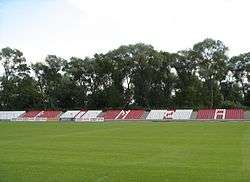 Stadium of ŁKS Łomża football club from Łomża
Stadium of ŁKS Łomża football club from Łomża Łomża Orlik Sports Complex
Łomża Orlik Sports Complex
Landmarks
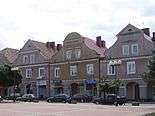 Tenement houses on the (Stary Rynek) Old Market Square
Tenement houses on the (Stary Rynek) Old Market Square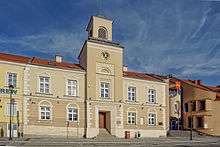 Łomża Town Hall (Ratusz)
Łomża Town Hall (Ratusz)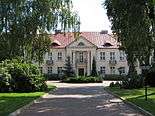 Episcopal Palace
Episcopal Palace Former State Bank (Bank Państwa) building
Former State Bank (Bank Państwa) building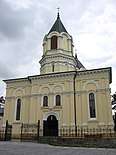 Church of the Assumption of Virgin Mary
Church of the Assumption of Virgin Mary Regional Court in Łomża
Regional Court in Łomża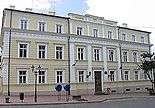 Main Post Office
Main Post Office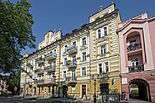 Śledziewski House (Kamienica Śledziewskich)
Śledziewski House (Kamienica Śledziewskich) Jakub Waga Park
Jakub Waga Park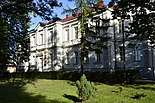 Former Holy Spirit Hospital
Former Holy Spirit Hospital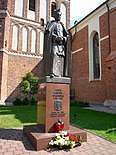 Monument to Cardinal Stefan Wyszyński
Monument to Cardinal Stefan Wyszyński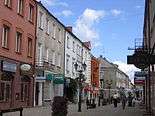 Farna Street
Farna Street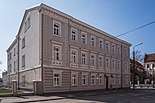 North-Masovian Museum (Muzeum Północno-Mazowieckie)
North-Masovian Museum (Muzeum Północno-Mazowieckie)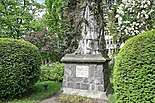 Monument to Stach Konwa
Monument to Stach Konwa.jpg) Śmiarowski cemetery chapel (19th century)
Śmiarowski cemetery chapel (19th century)
Notable residents
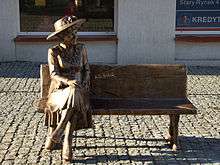
- Hanka Bielicka (1915–2006), Polish actress
- Andrew Bobola (1591–1657), Polish Roman Catholic saint
- Yehoshua Leib Diskin (1818–1898), rabbi
- Julita Fabiszewska (born 1991), Polish singer/songwriter; participant in Bitwa na głos.
- Yitzhak HaLevi Herzog (1888–1959), Chief Rabbi of Israel and father of Chaim Herzog, 6th President of Israel
- Adam Kownacki (born 1989), Polish Heavyweight boxer
- Samuel A. Levine (1891–1966), American cardiologist
- Michał Piaszczyński (1885–1940), Polish Catholic priest, killed by the German Nazis
- Rajmund Rembieliński (1774–1841), Polish nobleman, activist and landowner
See also
References
- Central Statistical Office (Poland): Population of cities in Podlaskie Voivodeship
- Qiryat Tiv'on, "Łomża from its beginnings," translated from Hebrew by Stan Goodman, original published by Pinkas haKehilot branch of Yad Vashem
- Marian Bagiński, Ph.D., "A Different View on the Łomża Region," published by PolishNews.com, 2010
- "Polish Murderers Sentenced: Convicted of killing at least twelve person in the forest". The New York Times. November 11, 1892. p. 8.
- "Slain by Trusted Guides: Poor Russian Emigrants Killed in the Forest Depths". The Washington Post. November 11, 1892. p. 1.
- Zamoyski, Adam (2008). Warsaw 1920 Lenin's failed conquest of Europe. Harpercollins Pub Limited. ISBN 9780007225521.
- Shapiro, Chaim. "Go, My Son: A Young Jewish Refugee's Story of Survival". New York: Feldheim, 1989.
- "The Russo-German War Today". The Baltimore Sun. June 25, 1941. p. 3.
- "Narew River Line in Poland Cracks: Reds Also Advance To Within 50 Miles Of Yugoslavia". Associated Press. The Baltimore Sun. September 6, 1944. p. 1.
- "Liczba mieszkańców Łomży, world-gazetteer.com". Archived from the original on 2012-05-15.
- Shapiro, Chaim (March 1974). "Lomza: A Yeshiva Grew in Poland" (PDF). The Jewish Observer. IX.
- "Million Men Battle: Over a Front of Eighty Miles Russians and Germans Meet". The Washington Post. March 12, 1915. p. 2.
- "Russians Rolled Back: Defeated Again in East Prussia, Declare Berlin Reports". The Washington Post. April 1, 1915. p. 11.
- "Berlin Reports Gains". The Baltimore Sun. May 5, 1915. p. 2.
- "Great Battle Begun for Warsaw: Forts of City Now Under Fire: Teutons Attack Fortresses of Lomza, Ostrolenka and Ivangorod". The Washington Post. August 5, 1915. p. 1.
- "Lomza Offensive Menaces: May Threaten Bialystok and Brest-Litovsk, Says Correspondent". The New York Times. August 7, 1915. p. 2.
- "Jews' Sufferings Grow: Aid Society Estimates the Number of Homeless at 100,000". The New York Times. June 5, 1915. p. 18.
- "Jews Machine-gunned". Associated Press. The Washington Post. October 30, 1941. p. 3.
- "2,500 Poles Executed: Mass Executions in Lomza and Bialystok Reported". The New York Times. November 14, 1943. p. 3.
- Łomża webpage at www.shtetlinks.jewishgen.org Archived November 1, 2011, at the Wayback Machine
- Edelheit, Hershel; Edelheit, Abraham J. (1991). A World in Turmoil An Integrated Chronology of the Holocaust and World War II. Greenwood Publishing Group. p. 216. ISBN 978-0-313-28218-8.
- Wertheimer, Gila (October 8, 1998). "Hidden Torah to be given new life". Chicago Jewish Star (Skokie, Illinois, USA). p. 1.
- Grant, Linda (November 8, 1998). "Poland's Promise: Writer Returns to Birthplace of Her Father, a Polish Jew, to Learn of Her Homeland". The Guardian. Pittsburgh Post-Gazette. p. F1.
- Namm, Leissah (March 18, 2000). "Rekindling Jewish Sparks: Descendants of Polish Jewish families protect memories and embrace future". Jewish News of Greater Phoenix (Phoenix, Arizona, USA). p. 10.
- (in Polish) Central Statistical Office, Poland - data of 2007 year Archived September 23, 2012, at the Wayback Machine
- (in Polish) County Labour Bureau in Łomża: Statistics of the local job market Archived September 21, 2013, at the Wayback Machine
- (in Polish) "Raport o sytuacji społeczno-gospodarczej miasta Łomża," Urząd Miejski w Łomży, November 2006 (77 pages)
- Bank Danych Regionalnych Głównego Urzędu Statystycznego, Łomża
- Statystyka Lokalnego Rynku Pracy, Powiatowy Urząd Pracy w Łomży Archived September 21, 2013, at the Wayback Machine
External links
| Wikimedia Commons has media related to Łomża. |
| Wikisource has the text of a 1911 Encyclopædia Britannica article about Łomża. |
